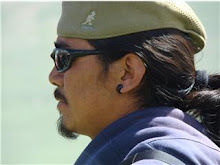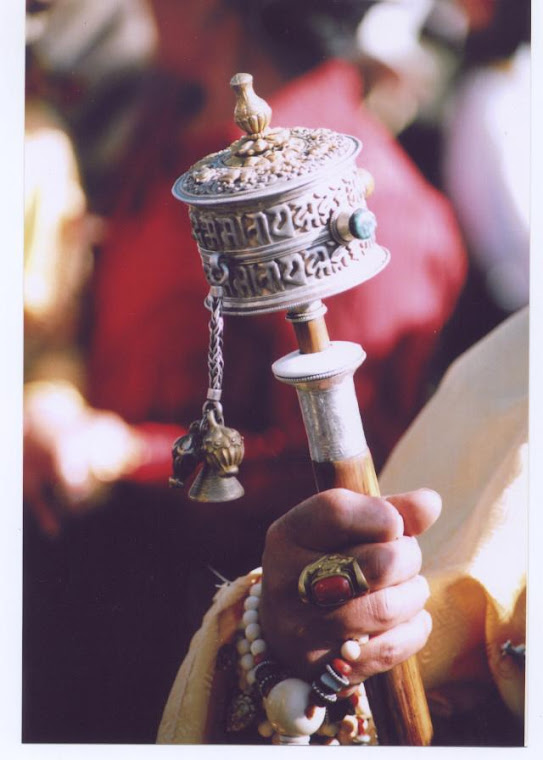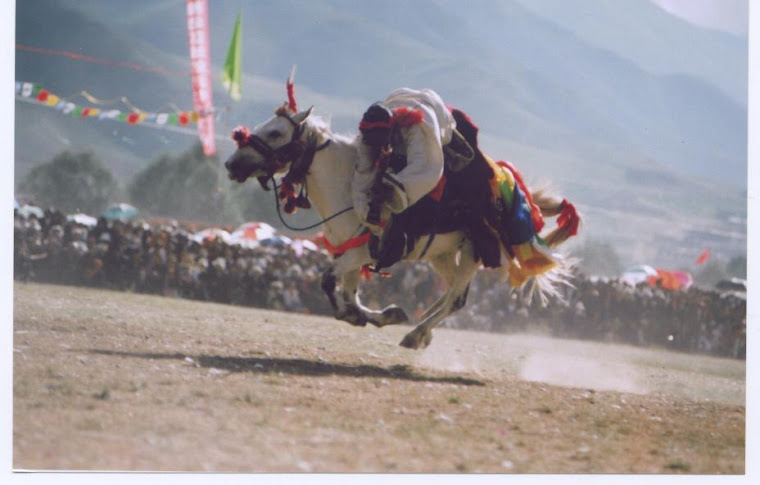
An Introduction To Tibetan Astro& Science
Tibetan Astro. Science is the ancient art of calculation and interpretation of celestial phenomena. We classify Astro. Science into two categories: Elemental Astrology (Byung-rtsis) and Astronomy (Kar-rtsis), and have drawn from the teachings of neighboring countries such as India, China, Persia and Greece in synthesis with the tenets of Buddhism to create a uniquely Tibetan system.
Elemental Astrology
Byung-rtsis or Elemental Astrology has been strongly influenced by the Chinese system of Elemental Astrology since the time of Tibet's first king, gNya-khTri-bsten-Po (2nd century B.C.). The practitioners of Tibet's ancient Bon religion had acknowledged the five elements many years earlier, and used a system of astrological prediction and divination which was similar to shamanism with its techniques of black and white magic and animal sacrifice. The Bon doctrines were presented in a detailed system of categories and sub-categories, two of which were Astrology and Medicine. The advent of Buddhism into Tibet in the 4th century A.D. also brought advances in the study of Astro. Science.
Tibetan astrologers observe the five elements of Wood, Fire, Earth, Metal and Water, twelve animal signs, and nine magic square numbers (sMewa). From China comes the principle of the eight Parkha. or trigrams, which are arranged in a circle around the sMewa within the astrological chart. One's life may be influenced by the planets and' their movement, one's past karma, or by beneficent or malevolent spirits. The spirits are classified into nine categories, represented by the nine numbers inside the sMewa; although the numbers change position within the square each year, one's birth sMewa will always remain constant. Each Parkha likewise symbolises a spirit or a deity; the eight Parkhas also move around the chart from year to year and their relationships to each other are said to be like a family, with positions of mother, father, eldest son and daughter, nephews and nieces. The Chinese principles of yin and yang find expression in the Parkhas and their concept of the Sky as the father and the Earth as the mother, and the ancient Chinese consulted the Parkhas on every subject from life prediction to military strategy.
The Tibetan Astrologer will examine the eight Parkhas, the nine sMewas, the 12 animals, and the five elements in conjunction with the individual's year, month, day and time of birth to construct a prediction about any of the four categories of life. The most important of these is Srog, or life energy, followed by Lus, health condition; Wangthang, financial situation; and rLungtha, or success. One's horoscope will feature observations and forecasts for each of the four categories. Where he notices an imbalance of energy in any of the four, he will recommend an antidote to offset negative influences or to prevent them in the future. Antidotes vary; one may be instructed to perform puja or to give alms, and more serious cases may require a ritual known as gto. In an effort to placate or deceive evil spirits, the practitioner may prescribe this ancient technique, which was first practiced in the Bon tradition. A doll is fashioned in effigy of the patient and is offered to the spirits in case of illness; before construction of important buildings, a small replica may be built and the evil spirits enticed to inhabit it. Gto is only practiced in the most desperate cases and in life-threatening situations.
The astrologer may also use Elemental Astrology in constructing a birth horoscope, a marriage computability chart, yearly predictions (skag rstis), medical calculations and death calculations. Since the 2nd century B.C., Elemental Astrology was in wide use, and it remained close to the Bon tradition for hundreds of years. During the 7th century A.D., the king's fifth wife, a Chinese princess and an accomplished astrologer, brought many books on Elemental Astrology and medicine from China. Thus the Bon and Buddhist astrological principles were influenced by Chinese classical Elemental Astrology, as well as by astrological principles from several neighboring countries such as India and even Persia and Greece.
The eighth century A.D. saw the development of astrology and astronomy reach its peak, and is referred to as the "Golden Age" because every field of learning such as Dharma, Astro. Science and Medicine enjoyed its highest patronage and development. Many Dharma texts were translated into Tibetan at that time, and it is the high standards set by the scholars of that century that still inspire us at the Tibetan
Medical and Astro. Institute today. The 10th century A.D. saw a decline in Tibetan power and influence, due to weak leadership; but by the seventeenth century, Tibet, under the benevolent direction of the fifth Dalai Lama, Ngawang Lobsang Gyatsho, rose to its earlier glory and an official system of Astro. Science was established. This system was handed down to his regent Desi Sangyay rGyatso, compiled into a folio, and remains in use today.
Tibetan Astronomical System
The Sri Kalachakra Tantra is the basis of our astronomical system. First translated into Tibetan from Sanskrit in 1027 A.D.(Fire/Rabbit Year), this text has made it possible for us to construct our annual almanac and calendar. The Kalachakra Tantra, one of the highest expressions of the Buddhist philosophy, contains three chapters. The first chapter, or External Kalachakra, focuses on the creation of the universe, its cosmology, the movements of the planets and stars, the five elements, and chronological studies. The second chapter is the Internal Kalachakra, which concentrates on the chakras or energy centers of the body, its energy channels, and the effect that external forces such as planets and stars have on bodily organs. The third and final chapter the Alternative Kalachakra, is most important to meditation, yoga practice, empowerment teachings, taking of initiation, and visualisation of one's own personal deity (yidam).
The external Kalachakra explains that the Sun's movement through each of the astrological houses constitutes one year. Aries, the third month in the Tibetan Calendar, is also the first month in the Kalachakra New Year. In contrast to many other spiritual philosophies which may be based in legend, the Kalachakra system explains many phenomena in realistic terms in much the same way as modern astronomical science. For example, the eclipse of the Sun is explained by both modern astronomy and the Kalachakra system as the phenomenon of the Moon's path passing between the Sun and the Earth, whereas the Hindu Vedas attribute the eclipse to Rahu, the shadowy planet, swallowing the moon.
The principles shown in the Kalachakra Tantra also led to the creation of the Tibetan Annual Almanac, with which we can determine the precise day-to-day Position of stars, planets and signs of the zodiac. The first Almanac was prepared in the tsur luk tradition as founded by the third Karmapa Rangjung Dorjee, and the Tibetan Medical and Astro. Institute continues to publish a traditional Almanac each year according to the more advanced phug lug system.
The lunar-based Tibetan Calendar is different from both the Indian and Western calendars in significant ways. The first difference noticed by the Western observer is that our year has only 360 days, as well as skip-days (tsi chad-pa) or extra days (tsi Ihag-pa). To Buddhists and Hindus, the full moon and the new moon should fall exactly on the 15th and 30th days of the month; in addition, the lunar day is only 23.59 hours long as opposed to the 24-hour solar day. Each year has an animal and one of the five elements designated to it; 1995 is the Wood/Pig year and 1996 will be a Fire/Mouse year-. A sixty-year cycle is thereby created, and the Tibetans believe that at twelve-year intervals in the individual's life one will experience loss, difficulty and suffering; each twelfth year is termed an "obstacle year.
Tibetan and Indian astronomy share a conception of the planets, the stars, the constellations and the houses of the zodiac. The Tibetan and Indian systems recognise five planets (Mars, Mercury, Jupiter, Venus and Saturn) and twelve houses. The three outer planets are not recognised by Tibetan astrologers, as they don't appear in the Kalachakra Tantra; in addition, Tibetan astrologers believe that they are too far from the earth to exert a noticeable influence. The Sun, the Moon, Rahu and Ketu are believed to govern one's vital energy and energy channels, although they are not considered planets by Western astrologers.
The nomads and farmers of ancient Tibet used astronomy to study weather conditions and the positions of the stars, planets and constellations, and passed their knowledge down to later generations orally as there was no written language in Tibet at the time. To determine weather patterns and planting times and locations, they made lunar calculations and paid special attention to the Scorpio Mouse (Lag-so Korka) and the constellation sMen-du's (Pleiades) position in relation to the moon during the 15th night of the tenth month of the Tibetan year. This important calculation, the Nyadu Tagpa, made it possible to forecast the next year's fortune for the entire country.The North Star took on special significance to the early sky-watchers who termed it the "Stable Star of the North" Some nomads in the northern part of Tibet still believe that if they lose an animal they only have to locate the North Star and ask it to keep the animal for the night; the next day, they will easily be able to find it.
by Professor Jampa G. DagthonTranslated by Jhampa Kalsang




















No comments:
Post a Comment